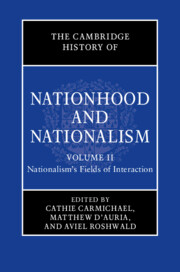Book contents
- The Cambridge History of Nationhood and Nationalism
- The Cambridge History of Nationhood and Nationalism
- The Cambridge History of Nationhood and Nationalism
- Copyright page
- Contents
- Figures
- Tables
- Contributors
- Part I Imperial and Postcolonial Settings
- Part II Transnational and Religious Missions and Identities
- 15 Liberalism and Nationalism: Trajectories of an Entangled Relationship
- 16 Marxism and the National Question
- 17 The Catholic Church
- 18 Islam and Nationalism
- 19 On Jewish Nationhood and Nationalism: A Historical Survey from Antiquity to the Establishment of the State of Israel
- 20 Buddhism
- Conclusion to Part II
- Part III Intersections: National(ist) Synergies and Tensions with Other Social, Economic, Political, and Cultural Categories, Identities, and Practices
- Index
Conclusion to Part II
from Part II - Transnational and Religious Missions and Identities
Published online by Cambridge University Press: 08 November 2023
- The Cambridge History of Nationhood and Nationalism
- The Cambridge History of Nationhood and Nationalism
- The Cambridge History of Nationhood and Nationalism
- Copyright page
- Contents
- Figures
- Tables
- Contributors
- Part I Imperial and Postcolonial Settings
- Part II Transnational and Religious Missions and Identities
- 15 Liberalism and Nationalism: Trajectories of an Entangled Relationship
- 16 Marxism and the National Question
- 17 The Catholic Church
- 18 Islam and Nationalism
- 19 On Jewish Nationhood and Nationalism: A Historical Survey from Antiquity to the Establishment of the State of Israel
- 20 Buddhism
- Conclusion to Part II
- Part III Intersections: National(ist) Synergies and Tensions with Other Social, Economic, Political, and Cultural Categories, Identities, and Practices
- Index
Summary
It is common to think of nationalism as a modern, secular form of identity that supplanted the influence long exercised by universalistic religions in shaping conceptions of temporal authority, membership, rights or privileges, and obligation in human societies. Under stereotypically modern conditions, religion is supposed to be largely confined to its own spiritual sphere, operating on a separate plane from that of the national. Yet the chapters in Part ii have shown how much more complicated the relationship between transcendentally transnational and boundedly national frameworks of belief and belonging can be. They are shown to operate not on separate, parallel planes, but as fields of belief and action that intersect, converge, and shape – as well as clash with – one another in myriad ways.
- Type
- Chapter
- Information
- The Cambridge History of Nationhood and Nationalism , pp. 459 - 464Publisher: Cambridge University PressPrint publication year: 2023

